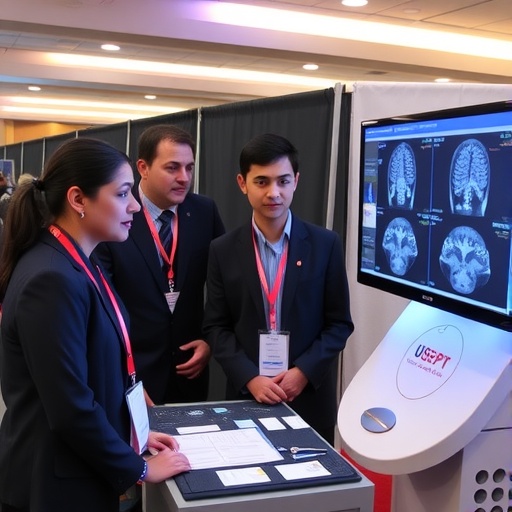In a groundbreaking development in the treatment of hormone receptor-positive breast cancer, recent findings have revealed that the novel PROTAC-based selective estrogen receptor degrader (SERD) known as vepdegestrant demonstrates superior efficacy compared to the currently used fulvestrant, particularly in advanced-stage estrogen receptor-positive (ER+) and human epidermal growth factor receptor 2-negative (HER2−) breast cancers harboring acquired ESR1 mutations. This advancement heralds a new era in targeted cancer therapy, leveraging cutting-edge molecular techniques to overcome one of the most challenging mechanisms of endocrine resistance.
Estrogen receptor-positive breast cancer constitutes the majority of breast cancer cases worldwide. The dependency of tumor growth on estrogen signaling has made selective estrogen receptor modulators (SERMs) and degraders (SERDs) pivotal in clinical management. Fulvestrant, the first US FDA-approved SERD, has been the benchmark for ER degradation therapy. However, its limited bioavailability, suboptimal receptor targeting in metastatic lesions, and inability to effectively counter resistance mutations prompted the search for novel agents. Vepdegestrant, a PROTAC (Proteolysis Targeting Chimera)-based SERD, is designed to harness the cell’s ubiquitin-proteasome system for more efficient receptor degradation, representing a significant mechanistic departure from traditional antagonists.
Endocrine resistance in ER+ breast cancer poses a substantial clinical dilemma. A key driver of this resistance is acquired mutations in the ESR1 gene, which encodes the estrogen receptor alpha (ERα). These mutations alter the ligand-binding domain of ERα, leading to constitutive receptor activation independent of estrogen, thus enabling tumor cells to proliferate despite endocrine therapy. Among these mutations, the Y537S and D538G substitutions have been identified most frequently in metastatic tumors following aromatase inhibitor therapy, associated with poor prognosis and treatment failure.
.adsslot_0j8fUxPuGg{width:728px !important;height:90px !important;}
@media(max-width:1199px){ .adsslot_0j8fUxPuGg{width:468px !important;height:60px !important;}
}
@media(max-width:767px){ .adsslot_0j8fUxPuGg{width:320px !important;height:50px !important;}
}
ADVERTISEMENT
The investigational drug vepdegestrant functions through a sophisticated molecular mechanism: PROTAC molecules consist of bifunctional compounds that simultaneously bind the target protein—in this case, ERα—and an E3 ubiquitin ligase, facilitating ubiquitination and subsequent proteasomal degradation. Unlike traditional SERDs, which competitively antagonize estrogen binding, PROTAC SERDs actively eliminate the receptor protein from the cell, yielding more complete and sustained suppression of ER signaling. This approach is particularly advantageous in the context of ESR1 mutations, where mere blockade of estrogen binding is insufficient.
Preclinical models have demonstrated that vepdegestrant induces rapid and potent degradation of wild-type and mutant ERα proteins across various breast cancer cell lines. These effects translate into marked inhibition of downstream estrogen-responsive gene expression, leading to reduced cell proliferation and enhanced apoptosis. Importantly, vepdegestrant maintains activity against the ESR1 mutant forms that diminish the efficacy of fulvestrant and other endocrine therapies, indicating a broad spectrum of action.
The comparative analysis of vepdegestrant and fulvestrant in patients with advanced-stage ER+ HER2− breast cancer bearing acquired ESR1 mutations demonstrates a significant improvement in progression-free survival and objective response rates with vepdegestrant. These clinical benefits are attributed to the superior receptor elimination ability of the PROTAC compound, which prevents receptor reactivation and circumvents mechanisms of compensatory signaling and resistance.
Mechanistically, vepdegestrant’s ability to leverage the ubiquitin-proteasome system also minimizes the accumulation of inactive receptor forms that can act as dominant positives in signaling. By ensuring near-complete receptor depletion, the drug exerts durable anti-tumor effects, reducing the likelihood of relapse. This is a profound advancement over fulvestrant, which exhibits partial receptor occupancy and degradation, allowing residual signaling activity.
Importantly, vepdegestrant displays a tolerable safety profile. The adverse events observed in clinical trials are manageable and predominantly include mild gastrointestinal symptoms and transient laboratory abnormalities. This favorable toxicity spectrum contrasts with broader endocrine therapies such as aromatase inhibitors, where off-target hormone suppression can lead to systemic side effects.
The implications of this research extend beyond breast cancer. The PROTAC technology exemplified by vepdegestrant represents a versatile platform capable of targeting a myriad of “undruggable” proteins implicated in diverse cancers and other diseases. By co-opting cellular quality control machinery, PROTACs hold the potential to revolutionize drug development, particularly for proteins resistant to classical small molecule inhibitors.
From a molecular oncology perspective, the targeting of ESR1 mutations underscores the importance of precision medicine strategies. Genomic profiling of metastatic lesions to detect ESR1 mutational status now becomes imperative for optimal patient stratification and therapy selection. The robustness of vepdegestrant against multiple resistance variants exemplifies an ideal targeted therapy in the era of tumor heterogeneity and molecular evolution.
Future research directions involve combination therapies pairing vepdegestrant with other targeted agents such as CDK4/6 inhibitors and PI3K pathway modulators. Synergistic interactions between these pathways could potentiate anti-tumor activity and forestall secondary resistance. Additionally, longitudinal monitoring of ESR1 mutational dynamics during treatment may inform adaptive therapeutic strategies, optimizing clinical outcomes.
Furthermore, the use of liquid biopsies for circulating tumor DNA analysis offers a minimally invasive approach to detect ESR1 mutations and to monitor therapeutic efficacy in real-time. Incorporating such biomarker-driven approaches will refine patient management, reduce unnecessary toxicity, and enhance cost-effectiveness in the clinical setting.
In conclusion, vepdegestrant represents a paradigm shift in endocrine therapy for ER+ HER2− breast cancer, particularly for patients exhibiting aggressive, treatment-resistant disease driven by ESR1 mutations. Its PROTAC-mediated mechanism promises enhanced degradation efficiency, better clinical outcomes, and improved quality of life. These findings are poised to reshape treatment algorithms and invigorate the development of next-generation targeted therapies across oncology.
As this novel therapeutic advances through ongoing phase II and III clinical trials, oncologists and researchers alike anticipate its integration into standard-of-care regimens. The promise of overcoming endocrine resistance, a long-standing hurdle in ER+ breast cancer management, moves one step closer to reality. The success of vepdegestrant highlights the transformative potential of harnessing intracellular degradation pathways for durable cancer control.
The oncology community must now strategically plan for access, real-world evidence generation, and post-marketing surveillance to fully realize the benefits of this innovation. Furthermore, mechanistic insights gleaned from vepdegestrant’s development can fuel similar strategies for other receptor-driven cancers, expanding the therapeutic arsenal against malignancies long shadowed by therapeutic resistance.
Subject of Research: The study investigates the efficacy of the PROTAC-based selective estrogen receptor degrader (SERD) vepdegestrant in comparison to fulvestrant for the treatment of advanced-stage estrogen receptor-positive (ER+) and HER2-negative (HER2−) breast cancer harboring acquired ESR1 mutations.
Article Title: PROTAC SERD vepdegestrant outperforms fulvestrant for advanced-stage ER+HER2− breast cancer harbouring acquired ESR1 mutations.
Article References:
Neven, P., Han, S.N. PROTAC SERD vepdegestrant outperforms fulvestrant for advanced-stage ER+HER2− breast cancer harbouring acquired ESR1 mutations. Nat Rev Clin Oncol (2025). https://doi.org/10.1038/s41571-025-01062-6
Image Credits: AI Generated
Tags: advanced-stage breast cancer treatmentsendocrine resistance mechanismsESR1 mutations in breast cancerestrogen signaling in cancer therapyhormone receptor-positive breast cancermutant estrogen receptor positive breast cancernovel cancer therapeuticsovercoming endocrine resistancePROTAC-based selective estrogen receptor degradersSERD therapy innovationstargeted cancer therapy advancementsvepdegestrant vs fulvestrant




